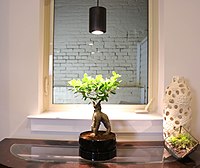
Photo from wikipedia
Based on the current trend towards broad-bandwidth LED light spectra for basil productions in multi-tiered controlled-environment horticulture, a recently developed white broad-bandwidth LED light spectrum (400-780 nm) including far-red wavelengths… Click to show full abstract
Based on the current trend towards broad-bandwidth LED light spectra for basil productions in multi-tiered controlled-environment horticulture, a recently developed white broad-bandwidth LED light spectrum (400-780 nm) including far-red wavelengths with elevated red and blue light fractions was employed to cultivate basil. Four Ocimum basilicum L. cultivars (cv. Anise, cv. Cinnamon, cv. Dark Opal and cv. Thai Magic) were exposed to two different rising light intensity conditions (ILow and IHigh). In dependence of the individual cultivar-specific plant height increase over time, basil cultivars were exposed to light intensities increasing from ~ 100 to ~ 200 µmol m-2 s-1 under ILow, and from 200 to 400 µmol m-2 s-1 under IHigh (due to the exponential light intensity increases with decreasing proximity to the LED light fixtures). Within the first experiment, basils’ morphological developments, biomass yields and time to marketability under both light conditions were investigated and the energy consumptions were determined to calculate the basils’ light use efficiencies. In detail, cultivar-dependent differences in plant height, leaf and branch pair developments over time are described. In comparison to the ILow light conditions, IHigh resulted in accelerated developments and greater yields of all basil cultivars and expedited their marketability by 3-5 days. However, exposure to light intensities above ~ 300 µmol m-2 s-1 induced light avoidance responses in the green-leafed basil cultivars cv. Anise, cv. Cinnamon and cv. Thai Magic. In contrast, ILow resulted in consumer-preferred visual qualities and greater biomass efficiencies of the green-leafed basil cultivars and are discussed as a result of their ability to adapt well to low light conditions. Contrarily to the green-leafed cultivars, purple-leafed cv. Dark Opal developed insufficiently under ILow, but remained light-tolerant under IHigh, which is related to its high anthocyanin contents. In a second experiment, cultivars’ volatile organic compound (VOC) contents and compositions over time were investigated. While VOC contents per gram of leaf dry matter gradually decreased in purple-leafed cv. Dark Opal between seedling stage to marketability, their contents gradually increased in the green cultivars. Regardless of the light treatment applied, cultivar-specific VOC compositions changed tremendously in a developmental stage-dependent manner.
Journal Title: Frontiers in Plant Science
Year Published: 2022
Link to full text (if available)
Share on Social Media: Sign Up to like & get
recommendations!